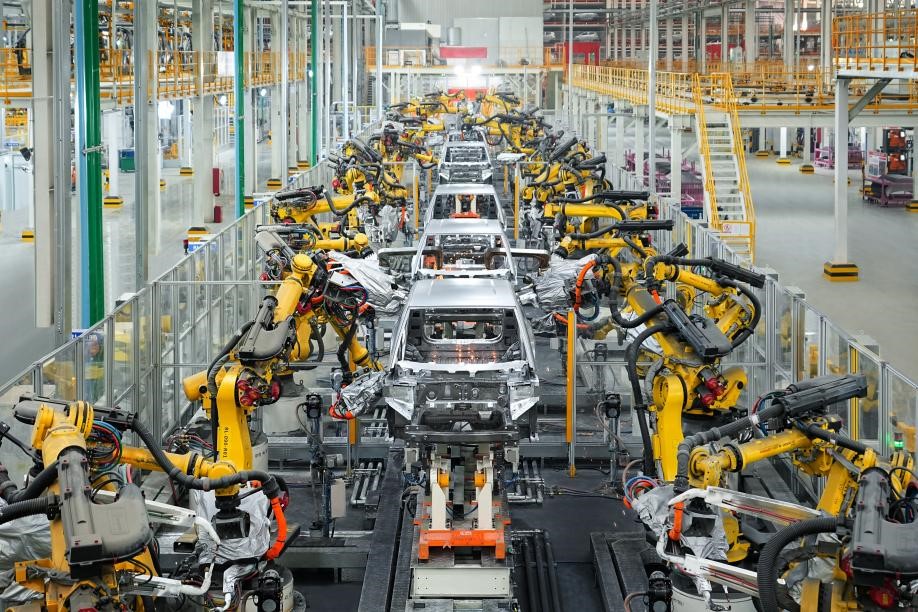Battery electric vehicles will cost less to produce than an equivalent ICE model by 2027, overcoming one of the traditional barriers to adoption, analysts Gartner reports.
Alongside factors such as lack of availability of suitable models and insufficient charging infrastructure, the higher purchase price of BEVs against equivalent petrol or diesel models has hindered adoption of the zero emission vehicles.
However, new production methods developed by new brands will change this, with legacy OEMs having to catch up or face the economic penalties.
“New OEM incumbents want to heavily redefine the status quo in automotive,” says Pedro Pacheco, vice-president of research at Gartner.
“They brought new innovations that simplify production costs such as centralised vehicle architecture or the introduction of gigacasting that help reduce manufacturing cost and assembly time, which legacy automakers had no choice to adopt to survive.”
The next few years will significantly change the market, he adds, as the EV sector enters a new phase.
Its research produced three major findings:
- By 2027, next-generation BEVs will, on average, be cheaper to produce than a comparable ICE vehicle
- By 2027, the average cost of an EV body and battery serious accident repair will increase by 30%
- By 2027, 15% of BEV companies founded in the past decade will be acquired or bankrupt
Here, we look at the findings in more depth.
BEV production costs slashed
Gartner predicts next-generation BEVs will, on average, be cheaper to produce than a comparable ICE vehicle by 2027.
As OEMs move on to disruptively transform their manufacturing operations in tandem with product design, the coming years will see BEV production costs drop considerably faster than battery costs.
“This means BEVs will reach ICE cost parity much faster than initially expected, but at the same time will make repairs of BEVs considerably costlier,” says Pacheco.
A significant reason in the lower production costs is the increasing use of gigacasting in the construction of BEVs.
This is a manufacturing process which involves casting large single pieces of vehicle underbodies in aluminium to replace several smaller pieces.
This production process was pioneered by Tesla in 2020 when it started combining dozens of chassis pieces into one entire section for its Model Y range.
Toyota last year announced it would follow, and the process is estimated to have the potential to cut manufacturing costs by 30%.
Increased repair costs
However, critics of gigacasting say repairs will be more costly and complicated because large sections of the car are affected in even minor collisions.
Gartner predicts that by 2027, the average cost of an EV body and battery serious accident repair will increase by 30%.
As a result, vehicles suffering a collision may be more prone to a total write-off as the repair could cost more than its residual value.
Equally, more expensive crash repairs may lead to more expensive insurance premiums or even the refusal of insurance companies to cover particular car models.
“Some of these new ways of building the vehicle also bring drawbacks in terms of repair costs. Or at least it’s not clear yet how these OEMs will be able to reduce repair costs at this level,” says Pacheco.
“In the case of gigacastings, there is no known process for repair that can be done in a cost-effective way.
“For a conventional floorplan, you might stretch it in order to bring it back to the original dimensions, but with the gigacasting it’s not clear yet.
“It could potentially be the OEMS using castings might develop processes to make the repairs cheaper for the sake of drivers and vehicle owners, but at the moment it’s not really clear what is obviously going to happen.”
Other construction methods could also adversely affect BEV repair costs compared to those from ICE vehicles, says Pacheco.
“For instance, when you have a structural battery to allow you to reduce the number of components, whenever you have a problem in the battery, it becomes very hard just to replace a cell,” he adds.
“In the end, the solution ends up having to replace the whole battery, which is a major cost.
“Of course, some OEMs are already setting up facilities for battery manufacturing or putting in place processes that allow dealerships to physically do repairs on batteries, or at least establishing regional hubs that can repair those batteries, so you can just replace the components that are defective or malfunctioning.
“But not all OEMs are doing that, so it could be a problem.”
Although reducing the production costs is of massive importance as the prices of BEVs needs to come down to encourage uptake, this should not be done at the expense of higher repair costs as it may generate consumer backlash in the long run, says Gartner.
“If someone buys an EV but has a crash and the car is basically a write-off, this generates issues in terms of insurance premiums, customer dissatisfaction and so forth,” says Pacheco.
“And then once you go into independent repair shops, are they going to be able to repair these cars? Do they have the knowledge at this moment?”
“Automakers can address the issues, but the focus needs to be there,” says Pacheco. “They need to put the solutions on the market and enable them.”
Vehicle manufacturer shake-up
The evolving technologies will change the manufacturer make-up of the new car market - it is already being seen in the UK as with other countries, with newcomers such as Tesla and more recently Chinese manufacturers such as BYD making an impact.
In the past, this has sparked predictions by some analysts that a significant number of the existing vehicle manufacturers will go out of business as they will not be nimble enough to compete with the newcomers.
“Legacy OEMS haven’t failed yet, but we’re obviously talking about very large, strongly-established companies,” says Pacheco.
“The automotive sector as a whole is slower than, for instance, consumer electronics in the sense that every year you have a new smartphone and sometimes things change radically year-on-year.
“Even though the automotive sector is now changing faster than ever, the product cycle is still six years.
“It’s worth keeping this in mind as what are seeing now doesn’t mean that legacy OEMS are out of danger because the risk comes when the penetration of BEVs keeps growing.
“This has been supported by incentives and regulation, as well as new incumbents that are growing aggressively.
“You see the likes of Tesla making the world’s best-selling model, so that’s quite conclusive, while BYD is also making a lot of waves in the mainstream sector.”
Despite the success of these two manufacturers giving a good example of what new brands can do, this does not mean every start-up will have the same impact.
“Not all new incumbents have a brilliant performance, but this is what happens in the world of start-ups; not just in the auto sector, but in any sector,” says Pacheco.
“Statistically, more start-ups fail, but a small number turn into a unicorn and then eventually into a major disruptive player. I believe this will be the same in the automotive sector.
“For the legacy OEMS, this doesn’t mean they’re all going to go bankrupt - it just isn’t the case – but we will see a change in terms of market penetration; if BEV sales keep growing, sustaining their current market share is going to be harder.”
Pacheco says the market is changing form one in which early adopters were either encouraged to acquire BEVs through their environmental credentials or financial incentives, to into the mainstream where incentives are either significantly reduced or removed completely.
“This means to an OEM that in order to sell their BEV, the environmental credentials are not enough,” he adds. “There needs to be products that can beat ICE in a direct comparison.
“We are still not in a position where you can recharge a BEV as fast as you refuel a petrol car, so that means automakers need to be very good at leveraging the advantages of BEV technology to deliver more value than ICE vehicles could deliver. For instance, that could mean performance, software and other technology.
“If you have OEMs develop EVs and they’re lacklustre - for example, the charging time is too long, driving range is poor, they have no positives over an ICE - these products are condemned to fail.
“We are going to see this survival of the fittest more and more. It’s going to be a lot harder for the OEMs that develop run-of-the-mill products.
“This is also the reason why we are seeing some OEMs having problems in terms of stock management of new EVs while others are beating sales records.”
Gartner predicts that by 2027, 15% of EV companies founded since the last decade will be acquired or bankrupt.
“This does not mean the EV sector is crumbling. It is simply entering a new phase where companies with the best products and services will win over the remaining,” says Pacheco.






















Login to comment
Comments
No comments have been made yet.